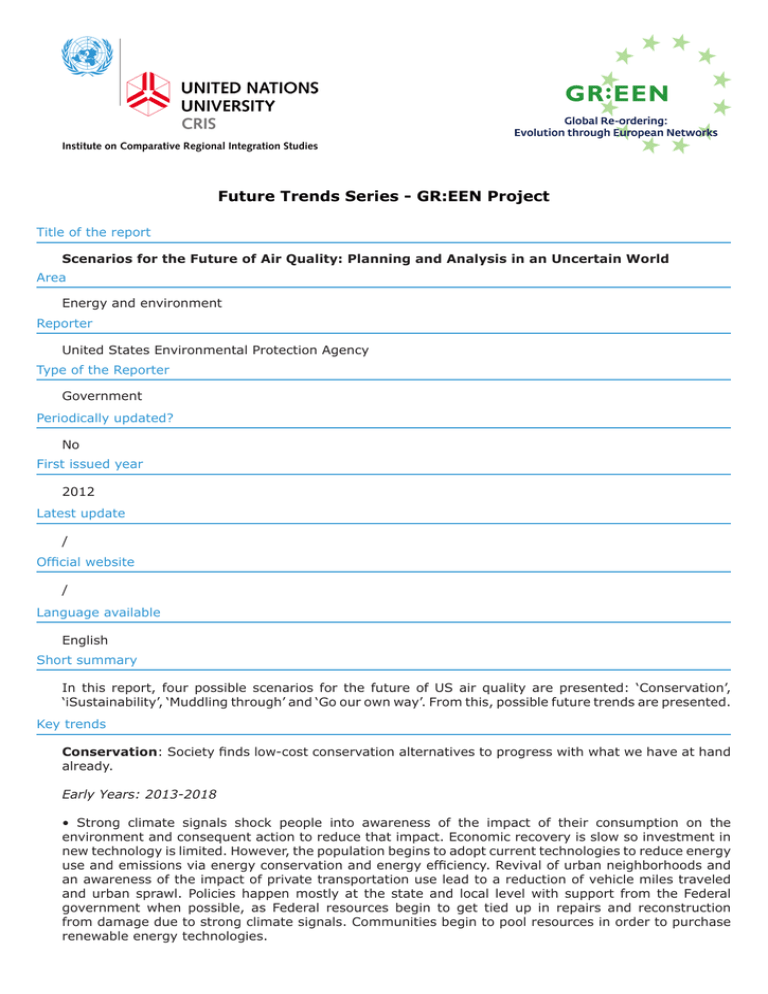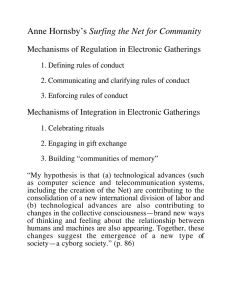Future Trends Series - GR:EEN Project
advertisement

Future Trends Series - GR:EEN Project Title of the report Scenarios for the Future of Air Quality: Planning and Analysis in an Uncertain World Area Energy and environment Reporter United States Environmental Protection Agency Type of the Reporter Government Periodically updated? No First issued year 2012 Latest update / Official website / Language available English Short summary In this report, four possible scenarios for the future of US air quality are presented: ‘Conservation’, ‘iSustainability’, ‘Muddling through’ and ‘Go our own way’. From this, possible future trends are presented. Key trends Conservation: Society finds low-cost conservation alternatives to progress with what we have at hand already. Early Years: 2013-2018 • Strong climate signals shock people into awareness of the impact of their consumption on the environment and consequent action to reduce that impact. Economic recovery is slow so investment in new technology is limited. However, the population begins to adopt current technologies to reduce energy use and emissions via energy conservation and energy efficiency. Revival of urban neighborhoods and an awareness of the impact of private transportation use lead to a reduction of vehicle miles traveled and urban sprawl. Policies happen mostly at the state and local level with support from the Federal government when possible, as Federal resources begin to get tied up in repairs and reconstruction from damage due to strong climate signals. Communities begin to pool resources in order to purchase renewable energy technologies. Middle Years: 2019-2023 • International pressures on oil and gas prices continue to push the U.S. towards increased adoption of renewable energy. The population is deeply concerned about climate change’s impacts on the U.S. as they have evidenced strong climate signals that are only getting worse. Problems with natural gas extraction using hydraulic fracturing steer people towards renewable energy. Fuel efficiency in industry, transportation and consumption continues to increase. Consumers demand more sophisticated information about the life cycle of the products they purchase. The trend toward more dense human settlements continues. End Years: 2024-2028 • Renewables have become prominent in the U.S. fuel mix with fossil fuels occupying a small proportion. The U.S. lags behind the rest of the world in terms of new energy technologies but continues with energy efficiency improvements. Climate signals have forced coastal populations to move inland. Energy savings are beginning to add up allowing the population some additional disposable income. iSustainability: Movement towards a new societal paradigm occurs from the bottom-up, armed with cutting-edge technologies. Early Years: 2013-2018 • With the economy starting to rebound around 2013, consumption levels begin to pick up. Technology breakthroughs spur job creation, and improve manufacturing processes and products. Support for more stringent environmental protection – whether on climate change, air quality, water quality or conservation – is low. Existing consumption patterns for goods and services are maintained, while technology helps reduce their environmental impact. Middle Years: 2019-2023 • General consumption patterns of energy, goods and services continue, with some efficiency and lifecycle environmental improvements enabled by technological innovations. By 2020, the climate signal is strong, leading to extreme flooding abroad and droughts in the U.S. Earlier advances in carbon capture technologies, and the rush to select and design injection sites, are followed in this period by poor performance of geological CO2 sequestration. Water shortages lead to a number of power plant shutdowns, extended blackouts and a record number of heat-related deaths. End Years: 2024-2028 • As we move toward 2030, the transformation that began in 2020 continues to play out. Earlier breakthroughs in nanotechnology and IT and investments in RD&D laid the groundwork for a technological transformation that opens up a range of possibilities with respect to energy production and use, manufacturing, mobility and land use. Technological advances are coupled with new societal attitudes and paradigms, which guide the development and use of technology towards more sustainable applications, whether in the home, vehicle, or manufacturing plant. Muddling Through: Society is divided about priorities; technological development mirrors societal gridlock. Early Years: 2013-2018 • Economic recovery is slow. Climate anomalies seem confusing to the public. Some believe they are climate change related, others think of them as natural random transitory phenomena. Energy efficiency improvements take place slowly, mostly to cater to a segment of the population that demands it. Middle Years: 2016-2023 • The economy begins to recover, resuming its growth. Existing patterns of consumption and consequent emissions continue along the same path as before. The population continues to be divided regarding what energy strategy to follow. The grid becomes increasingly vulnerable to extreme weather events. BRIC countries continue to put pressure on world primary energy supply pushing prices up. A lack of investment in biofuels and some other technologies means no significant breakthroughs are made regarding alternatives to fossil fuels. End Years: 2024-2028 • Climate worsens and resources are increasingly deviated from other productive uses towards repairing damages. Vulnerabilities in the supply of energy are revealed during extreme weather events. Go Our Own Way: Concerns over energy security override all other priorities, giving the environment a back seat. Early Years: 2013-2018 • With the overwhelming focus of the political and public debate centering on the need for economic growth and energy security, a renewed focus is given to developing domestic resources and imports from Canada and Mexico. This is driven by instability in the Middle East and the growing global demand for oil. Environmental issues remain a lower priority, and are widely perceived as a barrier to full exploitation of domestic resources. Societal attitudes and priorities center on economic growth. Middle Years: 2019-2023 • As technological advances continue, economic growth is high and energy production from new sources continues to expand. Consumption levels are high, and manufacturing grows substantially. As climate signals become clearer for the rest of the world, the lack of major impacts in the U.S. may foster a sense of indifference. End Years: 2024-2028 • By this end period, the U.S. has achieved what it considers to be energy security, in the form of energy produced predominantly in North America. Although societal patterns have changed little in terms of how and what people consume, a tipping point is being reached. At the same time, the climate signal is becoming clear, and this begins to redefine the extent to which the U.S. can indeed “go its own way” for the long run. Suggestions / Methodology Modelling Reference to other trends reports? If yes, which reports? /



